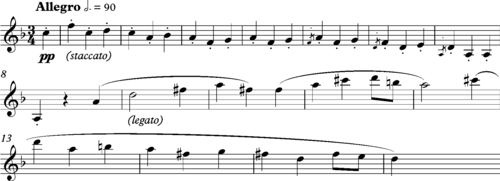


Articulation is a musical parameter that determines how a single note or other discrete event is sounded. Articulations primarily structure an event's start and end, determining the length of its sound and the shape of its attack and decay. They can also modify an event's timbre, dynamics, and pitch. [1] Musical articulation is analogous to the articulation of speech, and during the Baroque and Classical periods it was taught by comparison to oratory. [2]
Contents
- Articulations
- Procedure
- Brass and woodwind instruments
- Stringed instruments
- Compound articulations
- Apagados
- See also
- Notes
- References
- Bibliography
- External links
Western music has a set of traditional articulations that were standardized in the 19th century [3] and remain widely used. [1] Composers are not limited to these, however, and may invent new articulations as a piece requires. [4] When writing electronic and computer music, composers can design articulations from the ground up. [5]
In addition to the following instructions given by composers, performers choose how to articulate the events of a score independently, in accordance with their interpretation of it. Until the 17th century, it was rare to mark articulations in a score, and even during the Baroque period they were uncommon apart from ornaments, leaving them up to the performer and the standards of the time. Even during the Classical period, the interpretation of articulation marks varied far more widely than it does today. [6] Articulations have now become more tightly standardized, but performers still must consider the fashions of their time, methods of playing that were current at the time the piece they are performing was written, the context of their performance, the style of the music, and their own taste and analysis when deciding how to articulate a score's events. [7]



